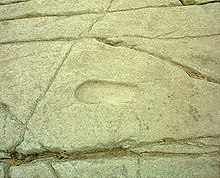Sole of the foot (rock carving)
Soles of the feet (sometimes also called sandals - Danish fodspor ; English footprints ; Norwegian Fotsåler ; Swedish fotsulor ) are a common pictorial element in rock carvings from the Nordic Bronze Age . They exist as petrosomatoglyphs (scratches on parts of the body), mainly on the hands and soles of the feet. In contrast to the hand depictions known since the Paleolithic in cave paintings , the soles of the feet are a motif on rock paintings that only appeared much later . They appear in Norway and Sweden at the earliest in the Neolithic Age , secured and in large numbers only in the Nordic Bronze Age, then also in England ( Calderstones , stone box from the Pool Farm ).
description
Sometimes the feet are shown individually, but in most cases in pairs. Representations of the soles of the feet come in different forms:
- With a dash that isn't a heel, but probably the strap that holds sandals in place.
- Barefoot with your toes (for example in the rock carvings by Lilla Flyhov and those by Madsebakke ).
- Filled (Skredsvik RAÄ No. 101: 2) or as a full outline.
There are some rock outcrops on which the soles of the feet are shown predominantly ( rock carvings by Järrestad ) or exclusively (Fåglum: 25 times in pairs and 20 times individually; field 2 of the rock carvings Leirfall shows about 90 foot soles arranged in pairs, rock carvings by Sporanes ). Joakim Goldhahn examined a Roese , on a slab of stone was built full footprints in children's size; an extremely rare example. It is difficult to say how much time passed between the completion of the incisions and the erection of the rose; it is certain that the placement was not accidental. The shale Pierre aux Pieds de Pisselerand in 1911 in the Maurienne , in the Savoie department, is covered with 33 pairs of soles, 16 individual soles and 50 bowls .
The stone of Scone , which shows inlaid footprints, is also known under the names Coronation Stone ( Coronation Stone ), Stone of Destiny (Stone of Providence / Destiny) and Gaelic Lia Fáil . Stones with footprints played a role in the medieval Irish-Scottish and later in the British coronation ritual .
Podomorfos
On the Iberian Peninsula , carvings on the soles of the feet (podomorfos) are characteristic of the ancient cultures of Galicia (Chan da Ferradura) and Portugal and of the Celtiberian culture. But they can also be found in the Canary Islands . In Portugal, they are rounded in shape, segmented or not, and often appear near watercourses.
Podomorfos have also been found on several of the Canary Islands. On Mount Tindaya in La Oliva on Fuerteventura , hundreds of images of human feet, presumably by the native inhabitants of the island, the majoreros , were carved into the rock. Podomorfos have been documented in at least eight sites on Lanzarote . There are also individual sites on El Hierro and Tenerife .
Sole carvings also occur in Sidi Maklouf (Algeria) and in Wadi Howar (Sudan),
Sandal soles
A specialty z. B. in the necropolis of Alapraia but also elsewhere in Portugal , there are replicas of votive sandal soles made of limestone , which were found by G. and V. Leisner in Stone Age dome tombs and were to be assigned to the bell-cup culture.
literature
- David A. Barrowclough, John Hallam: The Devil's Footprints and Other Folklore: Local Legend and Archaeological Evidence in Lancashire. In: Folklore. Volume 119, No. 1, 2008, pp. 93-102, doi : 10.1080 / 00155870701806233 .
- Nuno Ribeiro, Anabela Joaquinito, Sérgio Pereira: O Podomorfismo na Arte Rupestre da fachada Atlântica, que significado. In: Actas do V Encontro de Arqueologia do Sudoeste Peninsular. Almodôvar, 18 a 20 de novembro de 2010. Município de Almodôvar, Almodôvar (Beja) 2012, pp. 201-211.
- Kurt Schier : Scandinavian rock art as a source for the Germanic religious history? In: Heinrich Beck , Detlev Ellmers , Kurt Schier (eds.): Germanic religious history. Sources and source problems (= supplementary volumes to the Reallexikon der Germanischen Altertumskunde. 5). Walter de Gruyter, Berlin et al. 1992, ISBN 3-11-012872-1 , pp. 162–228, here p. 210 ff. ( Limited preview in the Google book search).
- Javier Soler Segura: Interpretando lo rupestre. Visiones y significados de los podomorfos en Canarias. In: TAPA. Traballos de Arqueoloxía e Patrimonio. Volume 33, 2005, ISSN 1579-5357 , pp. 165-177.
Individual evidence
- ↑ Revealed: carved footprint marking Scotland's birth is a replica , The Herald, September 22, 2007.
- ^ Alfredo Mederos Martín, Vicente Valencia Afonso, Gabriel Escribano Cobo: Arte rupestre de la prehistoria de las Islas Canarias . Ed .: Dirección General de Patrimonio Histórico. Gobierno de Canarias, Las Palmas de Gran Canaria, Santa Cruz de Tenerife 2003, ISBN 84-7947-350-9 , pp. 124 ff . (Spanish, [1] [accessed June 14, 2018]).
- ↑ Hans-Joachim Ulbrich: The podomorphic rock paintings of Lanzarote (Canary Islands) . In: Almogaren . No. 42 , 2011, ISSN 1695-2669 , pp. 133–168 ( [2] [accessed February 15, 2017]).
- ↑ Renata Ana Springer Bunk: The Libyan-Berber inscriptions of the Canary Islands in their rock painting context (= Berber Studies . Volume 42 ). Köppe, Cologne 2014, ISBN 978-3-89645-942-8 , pp. 46 .
Web links
- Rock painting in Fåglum (swedish)
- Soles of Järrestad (Engl.)
- Totak i Rauland (Norway.)



